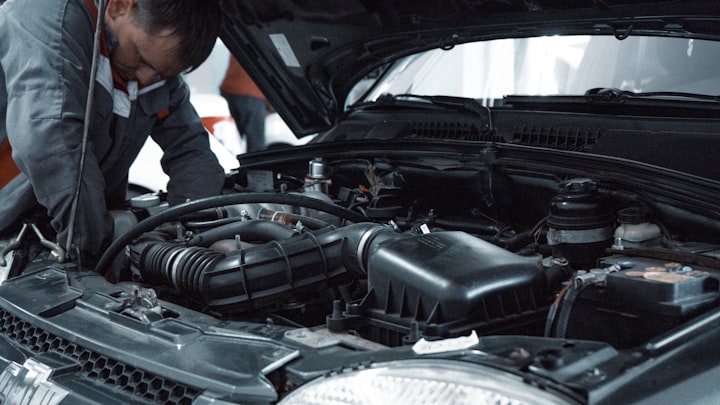8 Signs Your Oxygen Sensor Isn't Working (02 Sensor)
If your vehicle is acting up, book an appointment at a nearby garage online by searching for car service near me. Different engine performance problems and a dashboard check engine light are the most typical signs of a malfunctioning oxygen sensor.

Engine performance and fuel efficiency may suffer from a defective oxygen sensor. The most typical signs and symptoms are listed below.
If you're like most car owners, you probably don't give your car's oxygen sensors much thought until something goes wrong. Did you realise, though, that a malfunctioning oxygen sensor could affect your car's performance and potentially reduce its fuel efficiency?
To help you understand what's happening, we've covered the signs of a faulty oxygen sensor in this post. Additionally, we describe the purpose of the oxygen sensor and demonstrate where to find it. If you experience any of the symptoms listed in this piece, you should search online for car services near me garages and make an appointment as soon as possible.
A check engine light on your dashboard and other problems with engine performance are the most typical signs of a faulty oxygen sensor.
The eight signs that could foretell an imminent breakdown of the oxygen sensors are listed in further detail below:
1. The Check Engine Light Comes On - The Check Engine Light turning on is typically the first indication that something is wrong. There may frequently be an oxygen sensor-related issue code while you are completely symptom-free. The technician will be able to use a diagnostic instrument to scan any fault codes that will point towards the problematic location if you search online for car mechanics near me and schedule an appointment. In light of this, the mechanic can identify a wide range of trouble codes linked to an imbalance in the air-fuel combination that may ultimately be brought on by the oxygen sensor.
2. Reduced Fuel Economy - The proper amount of air and fuel must be mixed in the combustion chambers to avoid decreased fuel economy. Your faulty oxygen sensor might not be able to recognise it if there is more fuel than air. Your fuel efficiency drops as more fuel is burned in the engine. Your only option is to make more frequent journeys to the petrol station and spend more money at the pump.
3. Rough Idle - The idle is off if you've noticed that the car moves erratically when it's stopped or parked. A car should typically idle at 1,000 RPMs or less. There can be a problem with the oxygen sensor if it spikes. A malfunctioning oxygen sensor isn't usually indicated by a harsh idle, though. It might imply that any part involved in determining the air-fuel ratio is flawed. For this reason, you should search online for car maintenance near me garages and let a mechanic compare this symptom to the others to get the proper diagnosis.
4. Engine Stalling - The engine may stall if the idle is too harsh. This issue typically begins as a misfire and doesn't manifest until after the issue has gone unsolved. The engine will shut down if it cannot maintain the necessary level of power to continue operating. There are no assurances, but you ought to be able to restart it. If you do encounter this problem, look up car repairs near me online and schedule an appointment as soon as you can.
5. Poor Engine Performance - If the usual combustion process is stopped, you might anticipate experiencing problems with the engine's performance. Particularly when you try to press on the accelerator pedal, it will be weaker than usual. At first, this issue may be so undetectable that you fail to notice it. It's possible that the issues will worsen until driving becomes difficult. Therefore, it is crucial to get the issue investigated as soon as you become aware of it, particularly well before lack of acceleration causes a traffic collision.
6. Failed Emissions Test - Oxygen sensors are a component of the vehicle's pollution control system, which is why the emissions test failed. An emissions test would be able to detect an imbalance in the exhaust if they aren't functioning. While there are many reasons to fail these required tests, oxygen sensors frequently are a significant offender. When the test fails, have the computer checked for codes that could indicate the source of the issue.
7. Weird Sounds - If the air-fuel combination is not being monitored by an oxygen sensor, a lot of carbon may accumulate in the combustion chamber. The engines mixture could run lean as a result of this issue. Lean mixtures result in pre-ignition, which causes knocking or pinging noises. However, other factors, such as a clogged fuel injector, poor gasoline, or engine damage, might also cause these noises. These noises are typically audible when the engine is under load.
8. Failure of Catalytic Converter - What happens if you keep running the system with a malfunctioning oxygen sensor? Catalytic Converter Failure The imbalance of air and fuel will eventually lead the catalytic converter to malfunction. To prevent harm to the catalytic converter, the oxygen sensors must be functioning at their best. A catalytic converter replacement is never inexpensive. You should replace the faulty oxygen sensor just because it leads to more serious issues.
Oxygen Sensor Activity
Once the fuel and air in the cylinders have ignited, the vehicle engine performs a combustion process that results in exhaust gases. These exhaust gases include elements like oxygen and carbon among others. The oxygen sensors keep an eye on the concentration of these gases in the exhaust as it leaves the engine. This sensor determines how much oxygen is entering the combustion process.
The engine control module receives the data that was given from the oxygen sensor (ECM). This computer is in charge of processing all the data so that modifications to the fuel and air mixture can be made. When the ECM detects too much oxygen, other sensors will be adjusted to add more fuel, and vice versa. Otherwise, you're left with either a lean-running situation or a rich-running one, both of which cause engine issues.
In addition to causing engine problems, a faulty oxygen sensor may also cause additional harm to other parts. For instance, you are permitting additional wear to the costly catalytic converter as the imbalanced exhaust continues to pass through it. Therefore, repair work ought to be done right away.
Location of The Oxygen Sensor
The exhaust system houses the oxygen sensor. It might be seen on the exhaust manifold or close to the engine. Numerous oxygen sensors are included in many cars, but they all measure the amount of oxygen in the exhaust.
The second oxygen sensor, if the vehicle has one, will be found behind the catalytic converter. By comparing data taken before and after the converter, this sensor keeps track of how well it is working.
About the Creator
Car Services in Reading
Are you looking for a reputable and high-quality car garage in Reading ? Car Services in Reading is your one-stop shop for online garage services in Reading. Book online car repair services with us with confidence.






Comments
There are no comments for this story
Be the first to respond and start the conversation.